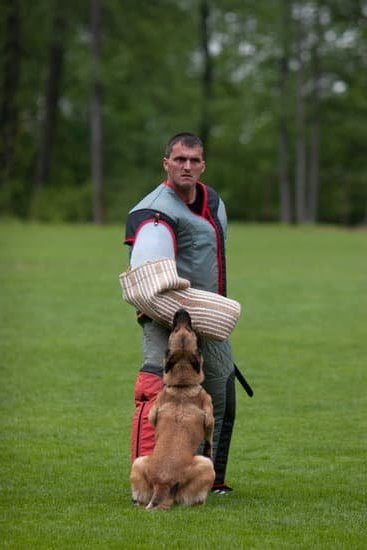Are you looking for an effective way to train your dog using a remote collar? Remote collar training can be a valuable tool in teaching your furry friend new behaviors and reinforcing obedience. In this article, we will explore the ins and outs of utilizing a remote collar for training purposes, from understanding its functionality to implementing basic commands and troubleshooting common issues.
Remote collar training involves the use of a specialized collar that delivers electronic stimulation to your dog as a form of communication. By properly setting up and using the remote collar, pet owners can teach their dogs various commands and behaviors with consistency and precision. This method is especially useful for off-leash training, as it provides a way to communicate with your dog even at a distance.
Choosing the right remote collar for your dog is crucial in ensuring successful training sessions. Each dog is unique, so it’s essential to select a collar that fits your pet comfortably and offers different levels of stimulation that are appropriate for their size and temperament. With the proper equipment in hand, you can begin setting up the remote collar correctly for training by following manufacturer guidelines and seeking professional advice if needed.
Understanding the Functionality of Remote Collars
Remote collars, also known as e-collars or shock collars, are tools that can be used to train dogs effectively. Despite their controversial reputation, when used correctly and responsibly, remote collars can be a valuable training aid. Understanding the functionality of remote collars is crucial before incorporating them into your dog training routine.
How Remote Collars Work
Remote collars work by delivering electronic stimulation or vibrations to the dog through a receiver collar worn around their neck. The stimulation levels can be adjusted according to the dog’s sensitivity and the specific training needs. Some advanced models also offer features such as tone or vibration modes, which can be used as alternatives to electronic stimulation.
Benefits of Using Remote Collars
One of the main benefits of using remote collars for training is the ability to provide immediate feedback to your dog from a distance. This means you can reinforce commands even when your dog is not within reach or off-leash. Additionally, remote collar training can help improve communication between you and your pet, leading to quicker and more effective results in obedience training.
Common Misconceptions About Remote Collar Training
There are several misconceptions surrounding the use of remote collars, with some people believing they are cruel or harmful to dogs. However, when used correctly following proper guidelines and instructions, remote collars can actually be gentle and humane tools for training. It is important to select a high-quality collar from reputable brands and seek professional guidance on how to properly train your dog using a remote collar.
Choosing the Right Remote Collar for Your Dog
When it comes to choosing the right remote collar for your dog, there are several factors to consider in order to ensure effective training. One of the most important aspects to look at is the size and breed of your dog. Different remote collars are designed for various sizes and temperaments of dogs, so it’s crucial to select one that is suitable for your pet.
Additionally, considering the intensity levels and features of the remote collar is essential. Some dogs may respond better to certain types of stimulations, so having adjustable settings can be beneficial in customizing the training experience for your furry friend.
Understanding the Different Types of Remote Collars
There are generally three types of remote collars available in the market: vibration, tone, and static stimulation. Vibration collars provide a gentle buzz to get your dog’s attention without any discomfort. Tone collars emit a sound that is meant to distract or redirect your dog’s behavior.
Lastly, static stimulation collars deliver a mild electric shock as a correction method. It’s important to research and understand how each type works before deciding which one would be most suitable for your dog’s training needs.
Consulting With a Professional Trainer
If you’re unsure about which remote collar would be best for your dog, consulting with a professional trainer can provide valuable insight. A certified trainer can assess your dog’s behavior and recommend the most appropriate remote collar based on their temperament and responsiveness.
They can also teach you how to properly use the device, ensure correct placement, and guide you on how to train your dog using a remote collar effectively while maintaining a positive relationship with them throughout the process.
Setting Up the Remote Collar Properly for Training
Remote collar training can be an effective tool in teaching your dog obedience and improving behavior. However, it is essential to set up the remote collar properly to ensure safe and successful training sessions. Before starting any training with a remote collar, it is crucial to read the manual that comes with the device thoroughly. Understanding how the remote collar works and the proper way to use it will prevent any potential harm to your furry companion.
One of the most important steps in setting up a remote collar for training is fitting it correctly on your dog. The collar should be snug but not too tight around your dog’s neck.
It is essential to find the correct size for your dog’s neck to ensure that the contact points are making proper skin contact without causing any discomfort. Additionally, make sure that the contact points are clean and free from debris before each training session to avoid skin irritation.
To effectively train your dog using a remote collar, you must also ensure that the settings on the device are appropriate for your dog’s size, breed, and temperament. Start with the lowest level of stimulation and gradually increase until you find the level at which your dog responds appropriately.
It is important to remember that every dog is unique, so what works for one may not work for another. Consistency, patience, and positive reinforcement are key elements in successful remote collar training sessions.
| Remote Collar Training Tips | Details |
|---|---|
| Read Instruction Manual | Thoroughly read and understand how to use the remote collar properly |
| Proper Fitting | Ensure that the collar fits correctly on your dog’s neck without causing discomfort |
| Adjust Settings Appropriately | Start at the lowest level of stimulation and adjust based on your individual dog’s response |
Basic Commands to Teach Your Dog With a Remote Collar
Training your dog using a remote collar can be an effective way to enhance your communication with your furry companion. When used correctly, remote collars can help reinforce commands and correct unwanted behaviors in a humane and efficient manner. One of the key aspects of using a remote collar is teaching your dog basic commands that will serve as the foundation for more advanced training.
The first command you should focus on when training your dog with a remote collar is “come” or “here.” This command is essential for safety and recall purposes, especially when your dog is off-leash. Start by associating the command with positive experiences such as treats or belly rubs. When using the remote collar to reinforce the command, make sure to use a low level of stimulation and gradually increase it only if necessary.
Another important command to teach your dog with a remote collar is “sit.” This basic obedience command helps instill discipline and control in your dog. Begin by luring your dog into a sitting position using treats or verbal cues. Once your dog understands the action, you can introduce the remote collar to reinforce the behavior. Remember to reward your dog whenever they respond correctly to the command, whether through treats, praise, or play.
Lastly, “heel” is a crucial command that teaches your dog to walk calmly beside you without pulling on the leash. Using a remote collar can be particularly helpful in correcting any pulling behaviors during walks. Start by practicing this command in a distraction-free environment before gradually introducing more challenging situations. With patience and consistency, you can train your dog to walk politely on a leash using a remote collar effectively.
| Command | Training Tips |
|---|---|
| Come/Here | Associate with positive experiences; start with low stimulation levels |
| Sit | Lure into sitting position; use collar for reinforcement; reward good behavior |
| Heel | Practice in distraction-free environments; correct pulling behaviors with collar |
Tips for Effective Training Sessions With a Remote Collar
Training your dog using a remote collar can be an effective way to improve obedience and behavior. However, it is important to approach this training method with care and consideration for your furry friend. Here are some valuable tips for conducting effective training sessions with a remote collar:
- Start with proper introduction: Before using the remote collar for training, make sure your dog is comfortable with the device. Introduce it gradually, allowing your dog to sniff and inspect it. This will help prevent any fear or anxiety during training sessions.
- Consistency is key: Just like any other training method, consistency is crucial when using a remote collar. Make sure to use the same commands and signals each time you train your dog. This will help them understand what is expected of them and minimize confusion.
- Positive reinforcement: While the remote collar can provide corrections, it is equally important to reward good behavior. Use treats, praise, and affection to motivate your dog during training sessions. This will create a positive association with the training process.
Effective communication: When using a remote collar, it’s essential to communicate clearly with your dog. Pay attention to their body language and reactions to determine if they understand the commands. Adjust the intensity of the collar accordingly and always remain patient and calm during training sessions.
By following these tips, you can ensure that your training sessions with a remote collar are not only effective but also enjoyable for both you and your canine companion. Remember that every dog is unique, so be patient and tailor your approach to suit their individual needs.
Troubleshooting Common Issues With Remote Collar Training
Remote collar training can be an effective way to teach your dog obedience and behavior, but like any training method, it may come with its own set of challenges. Here are some common issues that you may encounter when using a remote collar and how to troubleshoot them:
- Incorrect Fit: One of the most common problems with remote collars is having them fitted incorrectly on your dog. This can lead to discomfort for your pet and ineffective training results. Make sure the collar is snug but not too tight, with the contact points touching the skin.
- Confusion: Some dogs may become confused by the sensation of the stimulation from the remote collar, especially if they are not properly conditioned to it. It’s important to start with very low levels of stimulation and gradually increase as needed, while pairing it with positive reinforcement.
- Inconsistency: Consistency is key in any training method, including remote collar training. If you are inconsistent in using the remote collar for commands or corrections, your dog may have difficulty understanding what is expected of them. Set clear rules and boundaries during training sessions.
By addressing these common issues and following proper techniques, you can ensure that remote collar training is effective and beneficial for both you and your furry companion. Remember to always consult a professional trainer if you have any concerns or need additional guidance on how to train your dog using a remote collar.
Gradual Transition to Off-Leash Training With a Remote Collar
Transitioning to off-leash training with a remote collar can be an exciting and rewarding step in your dog training journey. This phase allows your dog to have more freedom while still maintaining control and safety through the use of the remote collar. However, it is crucial to approach this transition gradually and thoughtfully to ensure that your dog understands and follows commands even without a leash.
Before beginning off-leash training, it is essential to have established a strong foundation with on-leash training using the remote collar. Your dog should be proficient in basic commands such as sit, stay, come, and heel before attempting off-leash work. This solid foundation will help set your dog up for success when transitioning to off-leash training.
When transitioning to off-leash training with a remote collar, start by practicing in a secure and familiar environment with minimal distractions. Begin by allowing your dog some freedom on a long line while still giving commands with the remote collar. Gradually increase the distance between you and your dog while reinforcing commands with the remote collar.
Remember to praise and reward your dog for following commands correctly, reinforcing positive behavior during the transition process. With patience, consistency, and positive reinforcement techniques, you can successfully transition to off-leash training using a remote collar, strengthening the bond between you and your furry companion.
Maintaining a Positive Relationship With Your Dog During Training
Establishing and maintaining a positive relationship with your dog is crucial during training, especially when using a remote collar. It is important to remember that remote collars should be used as tools to communicate with your pet, not as punishment devices. Building trust and understanding between you and your furry companion is key to successful training outcomes.
One way to maintain a positive relationship with your dog during training with a remote collar is to always associate it with positive experiences. Before using the collar for training sessions, introduce it gradually to your dog by letting them sniff and explore it. Pair the collar with treats, playtime, and affection so that your pet associates the device with good things. This will help reduce any anxiety or negative reactions towards the remote collar.
Additionally, make sure to use gentle and consistent commands when training with a remote collar. Avoid yelling or harsh tones as this can create fear and confusion in your dog. Keep training sessions short, fun, and rewarding to keep your pet engaged and motivated.
Remember to praise and reward good behavior promptly to reinforce positive learning experiences while using the remote collar. By staying patient, understanding, and supportive throughout the training process, you can strengthen the bond between you and your canine companion while achieving desired results effectively.
Conclusion
Remote collar training can be a highly effective tool in teaching your dog obedience and improving their behavior. By understanding the functionality of remote collars and choosing the right one for your dog, you can set up successful training sessions. It is important to properly set up the remote collar to ensure it is safe and comfortable for your furry friend.
When using a remote collar, remember to start with basic commands like recall and sit before progressing to more advanced tasks. Consistency and patience are key in remote collar training, as well as positive reinforcement to encourage good behavior. Utilizing the collar correctly can lead to a well-behaved dog who understands boundaries and commands.
To ensure an enjoyable training experience for both you and your dog, it is crucial to maintain a positive relationship throughout the process. Be sure to praise your pup for their efforts and progress, creating a bond built on trust and respect. With dedication and proper guidance on how to train a dog using a remote collar, you can achieve the desired results and have a happy canine companion by your side.
Frequently Asked Questions
How Do You Train a Dog With a Remote Collar?
Training a dog with a remote collar involves starting with introducing the collar as a positive stimulus before using it for corrections. It’s essential to teach the dog to associate the collar with specific commands and not just punishment.
How Do I Get My Dog Used to an Electronic Collar?
To get your dog used to an electronic collar, it’s crucial to follow a gradual training process. Begin by allowing your dog to wear the collar without any stimulation, gradually introducing low levels of stimulation while reinforcing positive behaviors.
How Long Does It Take to Train a Dog With an Electric Collar?
The amount of time it takes to train a dog with an electric collar varies depending on the individual dog and their responsiveness to training. Consistency and patience are key factors in successful training with an electric collar, so it’s important not to rush the process in order to ensure long-term success.

Welcome to the blog! I am a professional dog trainer and have been working with dogs for many years. In this blog, I will be discussing various topics related to dog training, including tips, tricks, and advice. I hope you find this information helpful and informative. Thanks for reading!





